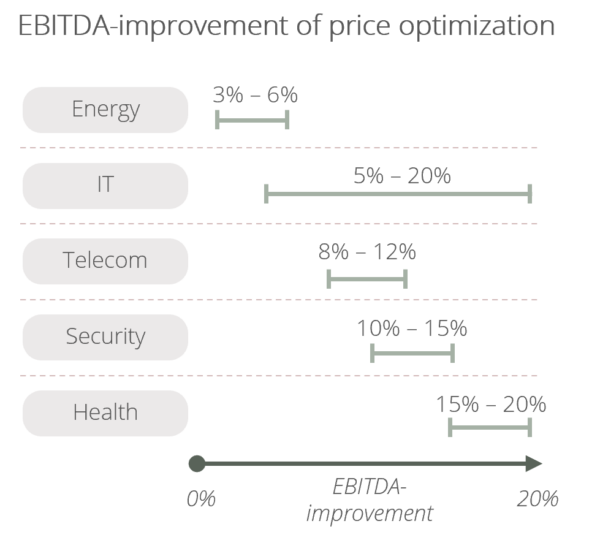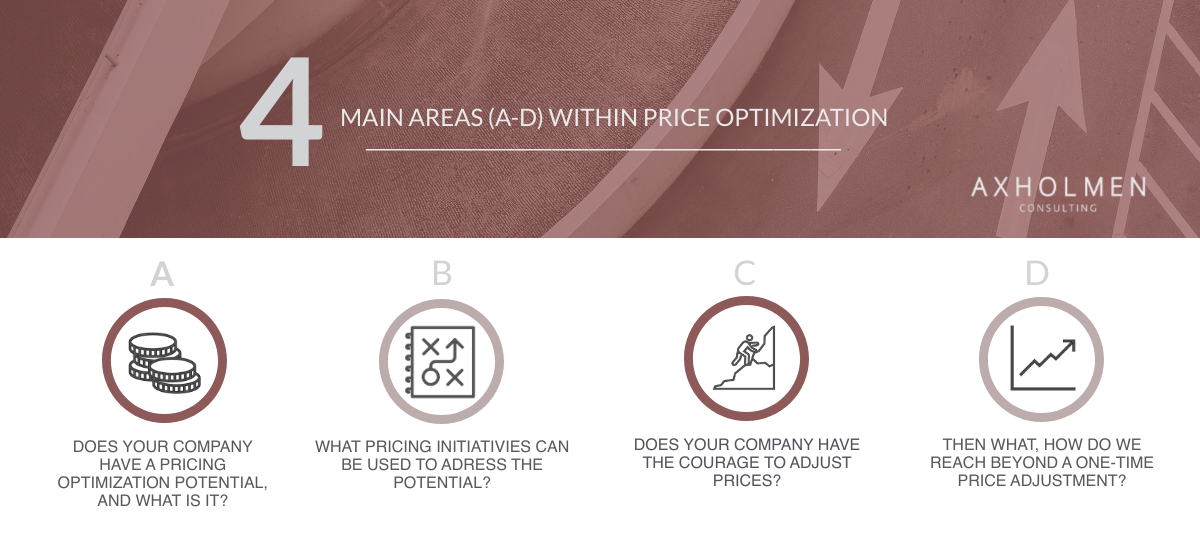Axholmen’s experience is that many companies have a large, untapped potential within pricing, where optimization is a lever for both growth and profitability. Deep understanding of the correlation between price, commercial model, packaging and purchasing decision is key but will not take you all the way. Psychological resistance in the organization, often driven by an exaggerated fear of negative customer reactions, is the most common reason for not reaching full potential.
When analysis is mixed with psychology

Introduction
Axholmen has extensive experience from commercial optimization within B2B, B2C and B2G in EMEA, North America, and APAC. In this White Paper we share key insights that have helped our clients to reach substantial results using pricing optimization as a lever. Based on our experience, we describe four main areas (A-D) to succeed with price optimization.


Four main areas (A-D) within price optimization
A. DOES YOUR COMPANY HAVE A PRICING OPTIMIZATION POTENTIAL, AND WHAT IS IT?
Axholmen’s experience finds that basically all companies have a potential to optimize pricing, but to what extent varies. Below are 6 common characteristics of companies with large potential:
- An appreciated product that customers are willing to pay for, e.g. a clear ROI or qualitative benefit that the customers value
- Small share of wallet, the products / services sold make up a small part of the customer’s total cost base
- Few equivalent substitutes exist on the market from price / quality perspective
- The products and / or services provide value for the customer over time, not only at the time of the purchase
- The price transparency is low on the market (competitors) and in the value chain (cost price), opportunity to price on value
- The customer base is large and price is either not tailored to each customer segment and / or there is unmotivated price spread within each customer segment
For companies that fulfill one or several of the criteria to the left, there could be large potential, see Figure 1.

The positive effects in the example above are a combination of improved take rate / conversion / win ratio / retention and increased average profitability per deal as result of pricing optimization
B. WHAT PRICING INITIATIVIES CAN BE USED TO ADRESS THE POTENTIAL?
One area that often has untapped potential is price adjustments on existing customer base. There are several different types of price initiatives, where the common denominator is to have a clear rational for the customer in combination with right timing. This is exemplified below:
- Transition to a new commercial model like subscription at upgrade / renewal / up sale
- Revision beyond Inflation / index as result of increased delivery and / or production costs
- Revision of commercial terms where your products or services are enhanced and deliver higher value for the customer
- Reduction of historical discounts at call-offs or renewals with rational linked to market and product changes or harmonization per segment
- Discount reductions if the actual volumes the customer purchased are lower than agreed, where the rational is that the commercial terms for the discount are not fulfilled
When looking at initiatives for new sales it is important that the company gathers insights to understand what price level is optimal for each situation. Companies that get most out of optimizing new sales pricing are characterized by:
- Strong analytical ability, where patterns between price, packaging and demand in different segments can be identified
- Clear understanding of price elasticity in the market, and ability to differentiate prices based on product value and willingness to pay in different customer segments. Leverage customer insights, the customers often sit on the answers to what they value most
- Seeing pricing as something other than just a one-off, working continuously with a/b tests, business intelligence, etc. to ensure optimal pricing at any point in time
- Using discounts that do not erode long term profitability, but instead strengthen competitiveness at point of sales, e.g. offering one quarter for free instead of lowering the monthly fee
Axholmen has 14 years experience from commercial optimization within B2B, B2C and B2G in EMEA, North America and APAC. In this White Paper we share key insights that have helped our clients to reach substantial results.

C. DOES YOUR COMPANY HAVE THE COURAGE TO ADJUST PRICES?
In D. Kahneman’s Nobel price awarded research, he identified that humans show 2,5 times stronger motivation to avoid pain / loss compared to achieve pleasure / winning. Sales professionals and decision makers are not more than humans, and naturally find the risks with changing prices as higher than the potential upside. The keys to create comfort and courage in the sales department when adjusting prices are carefulness and evidence through:
- Education to build awareness about the most common psychological pit falls
- Secure principles for when to terminate price initiatives if the desired effect is not achieved
- Use pilot tests in a limited but representative population of customers
- Measure customer reactions and effects from the pilot and use insights to scale up
- Work iteratively with adjusting initiatives and communication based on reactions and effects
Axholmen’s experience is that the fear of negative reactions from customers often is exaggerated compared to what we see in the actual outcome. A strategy for objection handling and preparation for possible outcomes / reactions is key to avoid churn.

D. THEN WHAT, HOW DO WE REACH BEYOND A ONE-TIME PRICE ADJUSTMENT?
Optimizing prices is a marathon, not a sprint, and endurance and structure are needed to secure that the work does not stop at a one-time adjustment.
At Axholmen, we see 3 important pillars to achieve continuous price optimization:
- Operationalize learnings and insights from conducted initiatives through structured ways of working and routines (e.g. for indexation, end of period contract handling, addressing historical discounts, etc.), secure hands-on support tools, updated sales support systems, and defined KPIs
- Appoint someone with a clear responsibility for pricing that continuously follows up and drives the work forward (e.g. CRO or CSO)
- Communicate success stories and effects early, where good examples and role models are visualized
Does your company want to understand more about your pricing potential?

Summary

Read more about how we can help your company

Want to know more? Contact author and responsible partner
Head of Axholmen’s Pricing offering
About Axholmen
Axholmen in short
Axholmen was founded in 2007 with the idea of providing a modern Swedish alternative to the global management consultancy firms. We are focused on profitability improvements that are delivered in close cooperation with our clients and with pragmatism as a core value
What we do
We have succeeded in building a large client base among leading Swedish, Scandinavian and Global companies as well as attracting and retaining top talent. We have accomplished this by delivering concrete results in strategic projects combined with a way of working in smaller, more senior teams, together with our client. Our clients describe us as both strategic and concrete by stating our ability to help them in finding the right solution to their most complex challenges and ensure that the solution is implemented and results are achieved
Who we are
Axholmen has a strong team if experienced management consultants that all share the idea that modern consulting services are justified by the actual results and financial value created. We are willing to share the commercial risk and tie a large portion of our fees to that the agreed results are achieved

Read our Whitepapers

Price optimization – Seven success factors that improve the acceptance rate for pricing adjustments
For many companies, a majority of revenue comes from the existing customer base in the form of ongoing agreements or new business from existing customers. Price adjustments or a transition to a new commercial model can be very important value adders – we share seven success factors that we believe affect the level of acceptance to a high degree regardless of industry and geography
Läs mer
Pricing – Immediate effect with limited risk
With the right pricing, you get immediate effect with limited business risk
Läs merFeel free to contact us for more information or to book an unconditional meeting

